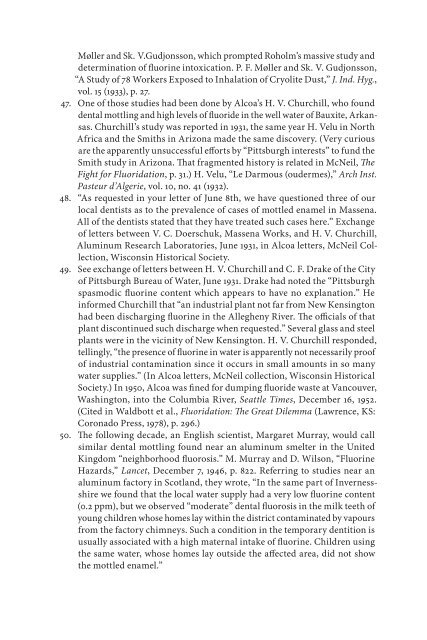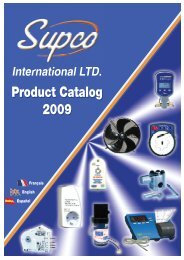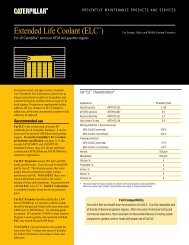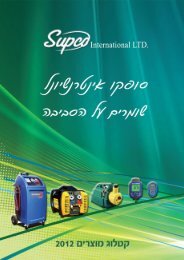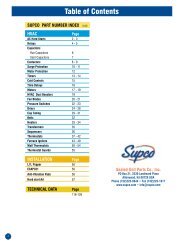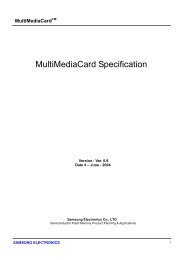Epigraphs Note on Terminology Acknowledgments Introduction
Epigraphs Note on Terminology Acknowledgments Introduction
Epigraphs Note on Terminology Acknowledgments Introduction
You also want an ePaper? Increase the reach of your titles
YUMPU automatically turns print PDFs into web optimized ePapers that Google loves.
Møller and Sk. V.Gudj<strong>on</strong>ss<strong>on</strong>, which prompted Roholm’s massive study and<br />
determinati<strong>on</strong> of fluorine intoxicati<strong>on</strong>. P. F. Møller and Sk. V. Gudj<strong>on</strong>ss<strong>on</strong>,<br />
“A Study of 78 Workers Exposed to Inhalati<strong>on</strong> of Cryolite Dust,” J. Ind. Hyg.,<br />
vol. 15 (1933), p. 27.<br />
47. One of those studies had been d<strong>on</strong>e by Alcoa’s H. V. Churchill, who found<br />
dental mottling and high levels of fluoride in the well water of Bauxite, Arkansas.<br />
Churchill’s study was reported in 1931, the same year H. Velu in North<br />
Africa and the Smiths in Ariz<strong>on</strong>a made the same discovery. (Very curious<br />
are the apparently unsuccessful efforts by “Pittsburgh interests” to fund the<br />
Smith study in Ariz<strong>on</strong>a. That fragmented history is related in McNeil, The<br />
Fight for Fluoridati<strong>on</strong>, p. 31.) H. Velu, “Le Darmous (oudermes),” Arch Inst.<br />
Pasteur d’Algerie, vol. 10, no. 41 (1932).<br />
48. “As requested in your letter of June 8th, we have questi<strong>on</strong>ed three of our<br />
local dentists as to the prevalence of cases of mottled enamel in Massena.<br />
All of the dentists stated that they have treated such cases here.” Exchange<br />
of letters between V. C. Doerschuk, Massena Works, and H. V. Churchill,<br />
Aluminum Research Laboratories, June 1931, in Alcoa letters, McNeil Collecti<strong>on</strong>,<br />
Wisc<strong>on</strong>sin Historical Society.<br />
49. See exchange of letters between H. V. Churchill and C. F. Drake of the City<br />
of Pittsburgh Bureau of Water, June 1931. Drake had noted the “Pittsburgh<br />
spasmodic fluorine c<strong>on</strong>tent which appears to have no explanati<strong>on</strong>.” He<br />
informed Churchill that “an industrial plant not far from New Kensingt<strong>on</strong><br />
had been discharging fluorine in the Allegheny River. The officials of that<br />
plant disc<strong>on</strong>tinued such discharge when requested.” Several glass and steel<br />
plants were in the vicinity of New Kensingt<strong>on</strong>. H. V. Churchill resp<strong>on</strong>ded,<br />
tellingly, “the presence of fluorine in water is apparently not necessarily proof<br />
of industrial c<strong>on</strong>taminati<strong>on</strong> since it occurs in small amounts in so many<br />
water supplies.” (In Alcoa letters, McNeil collecti<strong>on</strong>, Wisc<strong>on</strong>sin Historical<br />
Society.) In 1950, Alcoa was fined for dumping fluoride waste at Vancouver,<br />
Washingt<strong>on</strong>, into the Columbia River, Seattle Times, December 16, 1952.<br />
(Cited in Waldbott et al., Fluoridati<strong>on</strong>: The Great Dilemma (Lawrence, KS:<br />
Cor<strong>on</strong>ado Press, 1978), p. 296.)<br />
50. The following decade, an English scientist, Margaret Murray, would call<br />
similar dental mottling found near an aluminum smelter in the United<br />
Kingdom “neighborhood fluorosis.” M. Murray and D. Wils<strong>on</strong>, “Fluorine<br />
Hazards,” Lancet, December 7, 1946, p. 822. Referring to studies near an<br />
aluminum factory in Scotland, they wrote, “In the same part of Invernessshire<br />
we found that the local water supply had a very low fluorine c<strong>on</strong>tent<br />
(0.2 ppm), but we observed “moderate” dental fluorosis in the milk teeth of<br />
young children whose homes lay within the district c<strong>on</strong>taminated by vapours<br />
from the factory chimneys. Such a c<strong>on</strong>diti<strong>on</strong> in the temporary dentiti<strong>on</strong> is<br />
usually associated with a high maternal intake of fluorine. Children using<br />
the same water, whose homes lay outside the affected area, did not show<br />
the mottled enamel.”


